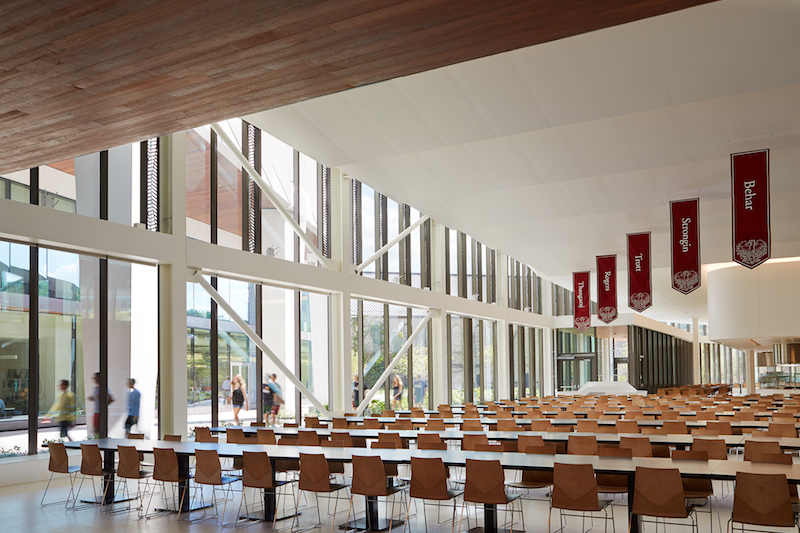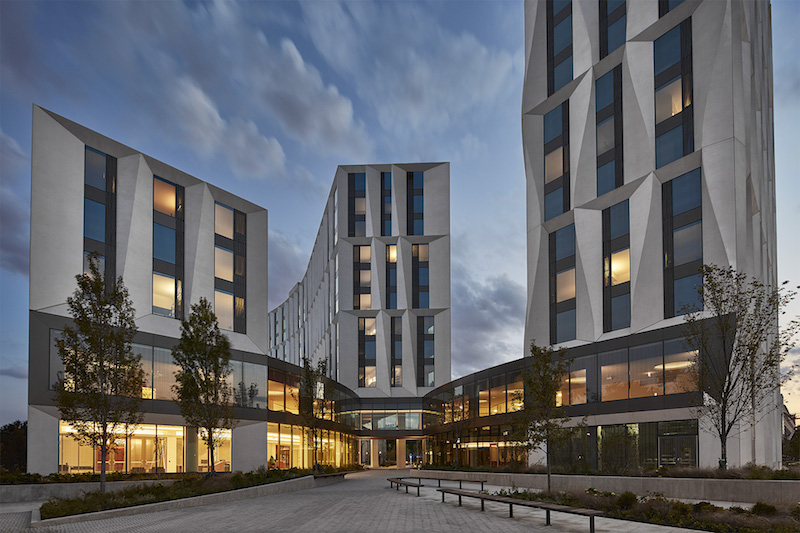On Saturday, Sept. 17, the University of Chicago will open its three-building, 394,000-sf Campus North Residential Commons that the college and its AEC partners are hoping can serve as a “front door” to the college.
The $150 million Commons, designed by Studio Gang Architects and built by Mortenson Construction, is situated on 195,480 sf at the north edge of campus. Its towers range from five to 15 stories tall, peaking at 164 feet. The towers have a total of 800 student beds within 252 single rooms and 193 double rooms that are organized into eight three-level “houses,” named after prominent members of the university’s community, including Dean John W. Boyer, who has led the college for the past 24 years.
“We designed an architecture that really feels like home for the students, but that simultaneously opens to and engages with the community,” Jeanne Gang, founding principal of Studio Gang Architects, told UChicagoNews.
The towers are connected by a second-floor common space. There are five music practices rooms and eight pianos; and two classrooms for campus-wide use. There is 23,603 sf of resident-only landscaped courtyards located above ground level. And a 48,791-sf green roof is set up to retain rainwater on site (the building is shooting for LEED Gold certification).
The top floor includes a multipurpose room, 14 group study spaces, and a 24-hour reading room. The first-floor area offers 12,000 sf of retail space for vendors Heritage Bicycles, Insomnia Cookies, TimBuk2 (which sells backpacks and messenger bags), and Dollop Coffee Co., whose shop is at the center of the building.
Other amenities include 118,150 sf of landscaped quadrangle, streetscape, and plaza. The university worked with the city to turn one street, Greenwood Avenue, into a pedestrian landscape connection linking the street on which the Commons sits with several athletic and arts centers on campus.

The 450-seat Frank and Laura Baker Dining Commons within the residential hall is organized so that students sit at tables whose names correspond to their residence “houses.” Image: Steve Hall ©Hedrick Blessing.
Within the Commons is the 28,000-sf Frank and Laura Baker Dining Commons, named after an alumnus, Frank Baker, who last year made a $7 million gift to the university to endow undergraduate scholarships and internships for lower-income students of outstanding promise. The dining room’s 450 seats are along tables designated for each of the Commons’ houses.
The building’s design lets in maximum natural light and fresh air into interior spaces. Each student’s residence comes equipped with automated controls to account for variable sun exposure as part of maintaining comfort.
The building’s external envelope consists of 1,034 white precast concrete panels (made from 110 different molds) hung on an aluminum curtain wall. And this building includes the first major application of a two-way radiant slab heating and cooling system in the Chicago region.
The other Building Team members on this design-build project were Magnussen Klemencic Associates (SE), dbHMS (MEP/fire protection engineer), David Mason & Associates (CE), Hanbury (associate architect), Hood Design Studio (landscape concept designer), Terry Guen Landscape Architects (landscape architect), Threshold Acoustics (acoustical designer), Lightswitch Architectural (lighting designer), Jensen Hughes (code consultant), Jenkins & Huntington (elevator consultant), and Transsolar (sustainability consultant).
Related Stories
| Aug 11, 2010
Precast All the Way
For years, precast concrete has been viewed as a mass-produced product with no personality or visual appeal—the vanilla of building materials. Thanks to recent technological innovations in precast molds and thin veneers, however, that image is changing. As precast—concrete building components that are poured and molded offsite—continues to develop a vibrant personality all it...
| Aug 11, 2010
Living and Learning Center, Massachusetts College of Pharmacy & Health Sciences
From its humble beginnings as a tiny pharmaceutical college founded by 14 Boston pharmacists, the Massachusetts College of Pharmacy & Health Sciences has grown to become the largest school of its kind in the U.S. For more than 175 years, MCPHS operated solely in Boston, on a quaint, 2,500-student campus in the heart of the city's famed Longwood Medical and Academic Area.
| Aug 11, 2010
Giants 300 University Report
University construction spending is 13% higher than a year ago—mostly for residence halls and infrastructure on public campuses—and is expected to slip less than 5% over the next two years. However, the value of starts dropped about 10% in recent months and will not return to the 2007–08 peak for about two years.
| Aug 11, 2010
Team Tames Impossible Site
Rensselaer Polytechnic Institute, the nation's oldest technology university, has long prided itself on its state-of-the-art design and engineering curriculum. Several years ago, to call attention to its equally estimable media and performing arts programs, RPI commissioned British architect Sir Nicholas Grimshaw to design the Curtis R.
| Aug 11, 2010
Setting the Green Standard For Community Colleges
“Ohlone College Newark Campus Is the Greenest College in the World!” That bold statement was the official tagline of the festivities surrounding the August 2008 grand opening of Ohlone College's LEED Platinum Newark (Calif.) Center for Health Sciences and Technology. The 130,000-sf, $58 million community college facility stacks up against some of the greenest college buildings in th...
| Aug 11, 2010
University of Arizona College of Medicine
The hope was that a complete restoration and modernization would bring life back to three neoclassic beauties that formerly served as Phoenix Union High School—but time had not treated them kindly. Built in 1911, one year before Arizona became the country's 48th state, the historic high school buildings endured nearly a century of wear and tear and suffered major water damage and years of...
| Aug 11, 2010
Cronkite Communication School Speaks to Phoenix Redevelopment
The city of Phoenix has sprawling suburbs, but its outward expansion caused the downtown core to stagnate—a problem not uncommon to other major metropolitan areas. Reviving the city became a hotbed issue for Mayor Phil Gordon, who envisioned a vibrant downtown that offered opportunities for living, working, learning, and playing.







